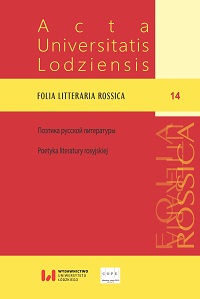Biblical Allusions in Contemporary Russian Poetry
DOI:
https://doi.org/10.18778/1427-9681.14.13Keywords:
Biblical allusions, modern Russian poetry, motif of retribution, motif of escape, motif of moving in a circleAbstract
The paper deals with enigmatic symbols presented in Biblical allusions in the texts of contemporary Russian poets Bakhyt Kenzheev, Evgeny Lesin, Ilya Falikov and Oleg Komkov. Three types of artistic symbols may be distinguished according to the criterion of their interpretative depth: empathic symbols are connected with the most important characteristics of existence, eidetic symbols remain in our memory due to the exceptional brightness of images, while enigmatic symbols constitute riddles to be deciphered. Biblical allusions in modern Russian poetry often belong to the third class of symbols. The allusions in the poems analysed are predominantly tragic in tone and develop the ideas of Ecclesiastes, with an emphasis on the incomprehensibility of the divine plan. The images of retribution to Sodom and flights to Egypt and from it illustrate the eternal circle of human existence. Bakhyt Kenzheev offers a new reading of the story of the destruction of Sodom, in which God’s messenger comes to the ruins of the city to see if there are any survivors after the apocalyptical retribution. A new dialogue with Ecclesiastes includes an image of an endless line of lanterns which may symbolise an after-death meeting of souls. In another poem of this author there is an allusion to the world’s annihilation as a necessary stage of the development of the Universe. Evgeny Lesin calls his country the last Sodom, and a place which he is reluctant to leave even though he is aware of its imminent fate. A new interpretation of the Exodus from Egypt is given by Ilya Falikov. In his take it becomes an eternal journey in a circle with no chance of escape. Oleg Komkov also treats this narrative in a new way: as a never-ending chain of death and resurrection. These allusions emphasise the idea that after creation, there inevitably comes destruction. The emphasis in the analysed texts is on a tragic perception of the world blended with an ironic attitude to it. Interpreting enigmatic symbols requires from the readers a creative participation in the dialogue with poets.
Downloads
References
Averintsev, Sergei S. Simvol. In: Filosofskii entsiklopedicheskii slovar, ed. L. F. Ilichev. Moskva: Sovetskaya entsiklopediya, 1983: 607–608.
Google Scholar
Esenin, Sergei A. Polnoe sobranie sochinenii: v 7 t., ed. Yu. L. Prokushev. Moskva: Nauka; Golos, 1995–2002.
Google Scholar
Falikov, Ilya Z. “Podzemnye molnii: stikhi”. Druzhba narodov. No. 5 (2009): 3–5.
Google Scholar
Karasik, Vladimir I. Yazykovaya matritsa kultury. Moskva: Gnozis, 2013.
Google Scholar
Kenzheev, Bakhyt Sh. Sochinitel zvezd http://modernpoetry.ru/main/bahyt-kenzheev-sochinitel-zvyozd
Google Scholar
Kenzheev, Bakhyt Sh. Stikhi poslednikh let. Moskva: [b. i.], 1992.
Google Scholar
Komkov, Oleg A. “Stikhotvoreniya”. Plavuchii most: zhurnal poezii. No. 1 (2014) http://www.plavmost.org/?p=663
Google Scholar
Lermontov, Mikhail Yu. Polnoe sobranie stikhotvorenii: v 2 t., ed. Yu. A. Andreev. Leningrad: Sovetskii pisatel, 1989.
Google Scholar
Lesin, Evgenii E. Avgust 14-go. http://www.reading-hall.ru/publication.php?id=12046
Google Scholar
Losev, Aleksei F. Problema simvola i realisticheskoe iskusstvo. Moskva: Iskusstvo, 1995.
Google Scholar
Lotman, Yurii M. Mezhdu emblemoi i simvolom. In: Lotmanovskii sbornik. Vol. 2. Moskva: Rossiiskii gosudarstvennyi gumanitarnyi universitet, 1997: 416–423.
Google Scholar
Lozinskii, Mikhail L. Bagrovoe svetilo: stikhi zarubezhnykh poetov v perevode M. Lozinskogo. Moskva: Progress, 1974.
Google Scholar
Mikhailova, Alla A. “Simvol, allegoriya, pritcha. Na putyakh khudozhestvennogo poznaniya mira (Znachenie uslovnykh form v iskusstve i literature)”. Znamya. No. 11 (1966): 213–229.
Google Scholar
Prorokov, Mikhail V. “Kategoriya khudozhestvennogo obraza i problema simvola (v literature)”. Vestnik Moskovskogo universiteta. No. 4 (1987): 39–47.
Google Scholar
Sheikin, Arkadii G. Simvol. In: Kulturologiya. Entsiklopediya: v 2 t. Vol. 2. Moskva: ROSSPEN, 2007: 457–458.
Google Scholar
Shelestyuk, Elena V. Semantika khudozhestvennogo obraza i simvola (na materiale angloyazychnoi poezii XX veka). Avtoreferat dissertatsii na soiskanie uchenoi stepeni kandidata filologicheskikh nauk. Moskva, 1998.
Google Scholar
Volskii, Aleksei L. Poetiko-filosofskii tekst kak obekt filologicheskoi germenevtiki. Avtoreferat dissertatsii na soiskanie uchenoi stepeni doktora filologicheskikh nauk. Sankt-Peterburg, 2008.
Google Scholar












